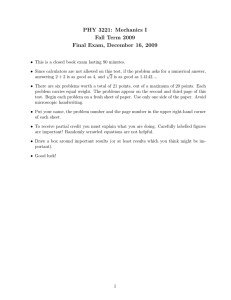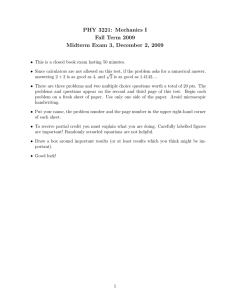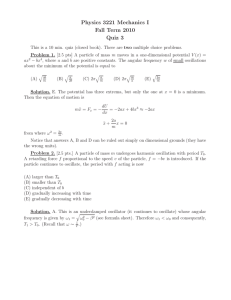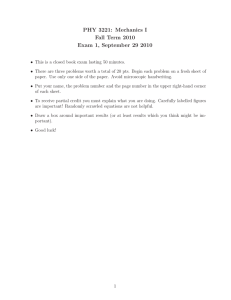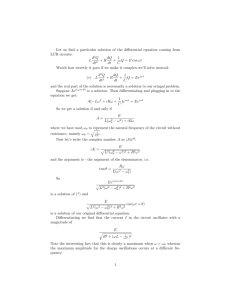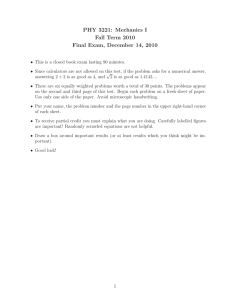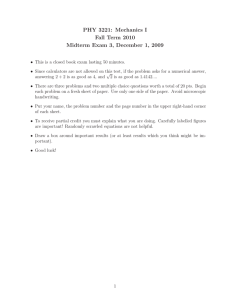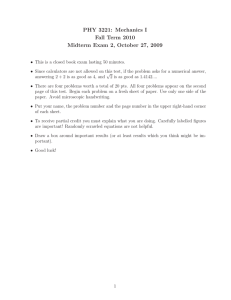PHY 3221: Mechanics I Fall Term 2010
advertisement
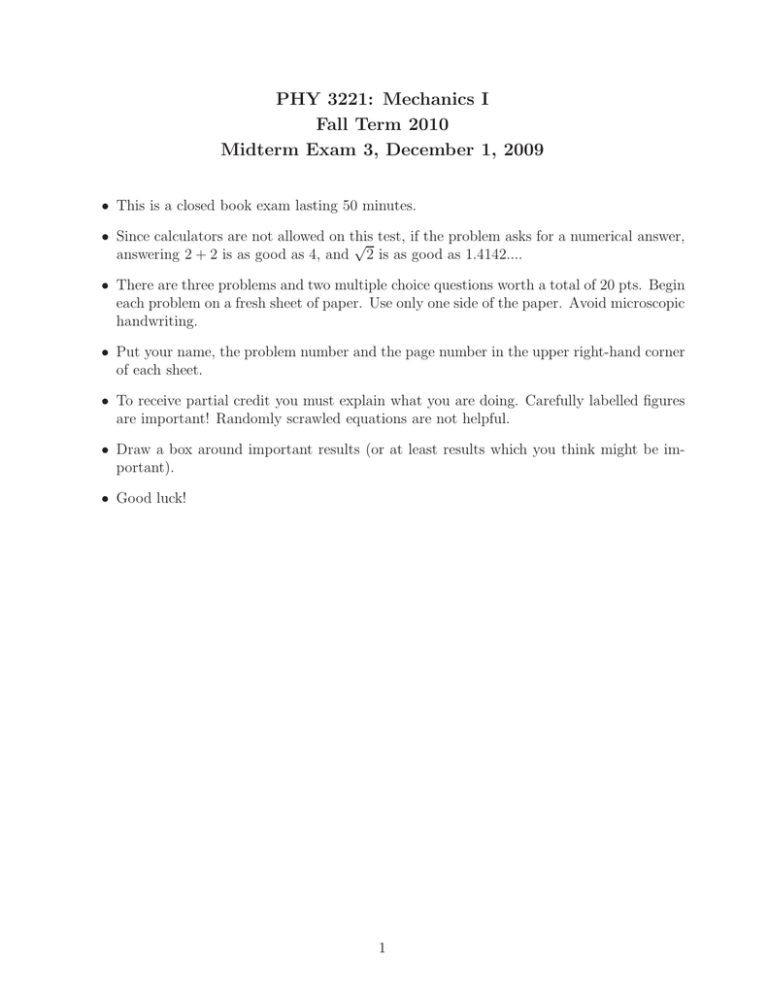
PHY 3221: Mechanics I Fall Term 2010 Midterm Exam 3, December 1, 2009 • This is a closed book exam lasting 50 minutes. • Since calculators are not allowed on this √ test, if the problem asks for a numerical answer, answering 2 + 2 is as good as 4, and 2 is as good as 1.4142.... • There are three problems and two multiple choice questions worth a total of 20 pts. Begin each problem on a fresh sheet of paper. Use only one side of the paper. Avoid microscopic handwriting. • Put your name, the problem number and the page number in the upper right-hand corner of each sheet. • To receive partial credit you must explain what you are doing. Carefully labelled figures are important! Randomly scrawled equations are not helpful. • Draw a box around important results (or at least results which you think might be important). • Good luck! 1 Problem 1. [2 pts] Which of the figures below depicts the response of a damped harmonic oscillator to a forcing function which is a single spike (delta function) applied at t = 0? A. Figure (a) B. Figure (b) C. Figure (c) D. Figure (d) Figure HbL 2 2 1 1 xHtL xHtL Figure HaL 0 0 -1 -1 -2 -2 0 -30 -20 -10 10 20 30 -30 -20 -10 t Figure HcL 10 20 30 40 50 Figure HdL xHtL 1.0 xHtL 0 t 1.5 0.5 0.0 -0.5 0 -20 E. Figure (e) 20 40 t 30 20 10 0 -10 -20 -30 -10 0 10 20 30 t xHtL Figure HeL 30 20 10 0 -10 -20 -30 -10 0 10 20 30 40 50 t Problem 2. [2 pts] A satellite of mass m orbits a planet of mass M in a circular orbit of radius R. The orbital period is: A. B. C. D. E. independent of M √ proportional to m proportional to R proportional to R3/2 independent of R. 2 Problem 3. [6 pts] Consider an underdamped oscillator with damping parameter β and characteristic angular frequency ω0 . The oscillator is initially at rest at its equilibrium position x = 0. Find the response of this oscillator to a forcing function of the form F (t) = 0, if t < 0, F0 e−βt , if t ≥ 0. Problem 4. [5 pts.] Find the gravitational force of attraction between an infinite wire of linear mass density λ = M and a point mass m situated a distance R away from the wire. L Problem 5. [5 pts.] In the 1989 animated movie “A Grand Day Out” Wallace and Gromit run out of cheese and build a home-made rocket to fly to the Moon and replenish their cheese supply. Let the mass of the Earth be M, the mass of the Moon be m, the radius of the Earth be R and the distance between Earth and Moon (center to center) be d (refer to the figure below). Compute the escape velocity V which Wallace’s rocket needs to have on the surface of the Earth, in order to be able to reach the Moon. You can ignore the effect of friction within the atmosphere, but make sure to account for the gravity of the Moon. Hint: think how far the rocket needs to get before the Moon’s gravity is able to pull it to the Moon’s surface. M R m V~ d Figure 1: An illustration for the Wallace and Gromit problem. 3 Formula sheet A·(B × C) = B·(C × A) = C·(A × B) ≡ ABC A×(B × C) = (A · C)B − (A · B)C (A × B) · (C × D) = A · [B × (C × D)] = A · [(B · D)C − (B · C)D] = (A · C)(B · D) − (A · D)(B · C) (A × B) × (C × D) = [(A × B) · D] C − [(A × B) · C] D = (ABD)C − (ABC)D = (ACD)B − (BCD)A v = ṙ er + r θ̇ eθ + r sin θφ̇ eφ a = + 2ṙ φ̇ sin θ + 2r θ̇φ̇ cos θ + r θ̈ sin θ eφ v = ṙ er + r φ̇ eφ + ż ez a = r̈ − r θ̇2 − r φ̇2 sin2 θ er + 2ṙ θ̇ + r θ̈ − r φ̇2 sin θ cos θ eθ r̈ − r φ̇2 er + r φ̈ + 2ṙ φ̇ eφ + z̈ ez X εijk εlmk = δil δjm − δim δjl k X εijk εljk = 2 δil j,k X εijk εijk = 6 i,j,k Time averages over one period T : 1 Z t+T 1 hsin ωti = dt sin2 ωt = T t 2 2 1 hcos ωti = T 2 Z t+T t dt cos2 ωt = Tidal force 2GmMm r cos θ D3 GmMm r sin θ = − D3 FT x = FT y 4 1 2 Simple harmonic oscillator: mẍ + kx = 0 x(t) = A sin(ω0 t − δ) x(t) = A cos(ω0 t − φ) s 2π = ω0 = 2πν0 = τ0 Damped oscillator: k m b ẍ + 2β ẋ + ω02 x = 0, 2β = m √ 2 2 √ 2 2 x(t) = e−βt A1 e β −ω0 t + A2 e− β −ω0 t Underdamped motion x(t) = Ae−βt cos(ω1 t − δ), ω1 = x(t) = e−βt (A1 cos ω1 t + A2 sin ω1 t) , q ω02 − β 2 ω1 = Critically damped motion q ω02 − β 2 x(t) = (A + Bt)e−βt Overdamped motion −βt x(t) = e Driven oscillator h ω2 t A1 e −ω2 t + A2 e i ω2 = , q β 2 − ω02 F0 ẍ + 2β ẋ + ω02 x = A cos ωt, A = m √ √ 2 2 − β 2 −ω02 t β −ω0 t −βt + A2 e A1 e xc (t) = e A xp (t) = q cos(ωt − δ) (ω02 − ω 2 )2 + 4ω 2β 2 −1 δ = tan q 2ωβ 2 ω0 − ω 2 ! ω02 − 2β 2 ωR Q= 2β ωR = RLC circuit VL = L Gauss’s law Z S dI dt VR = RI ~n · ~g da = −4πG 5 VC = Z V ρ dv q C Fourier series ∞ X 1 (an cos nωt + bn sin nωt) , F (t) = a0 + 2 n=1 2Z τ ω Z +π/ω F (t′ ) cos nωt′ dt′ = F (t′ ) cos nωt′ dt′ π −π/ω τ 0 ω Z +π/ω 2Zτ = F (t′ ) sin nωt′ dt′ = F (t′ ) sin nωt′ dt′ π −π/ω τ 0 an = bn Green’s function ′ G(t, t ) = 1 mω1 0, ′ e−β(t−t ) sin ω1 (t − t′ ), if t < t′ . x(t) = Z t F (t′ )G(t, t′ )dt′ −∞ 6 if t ≥ t′ ,
